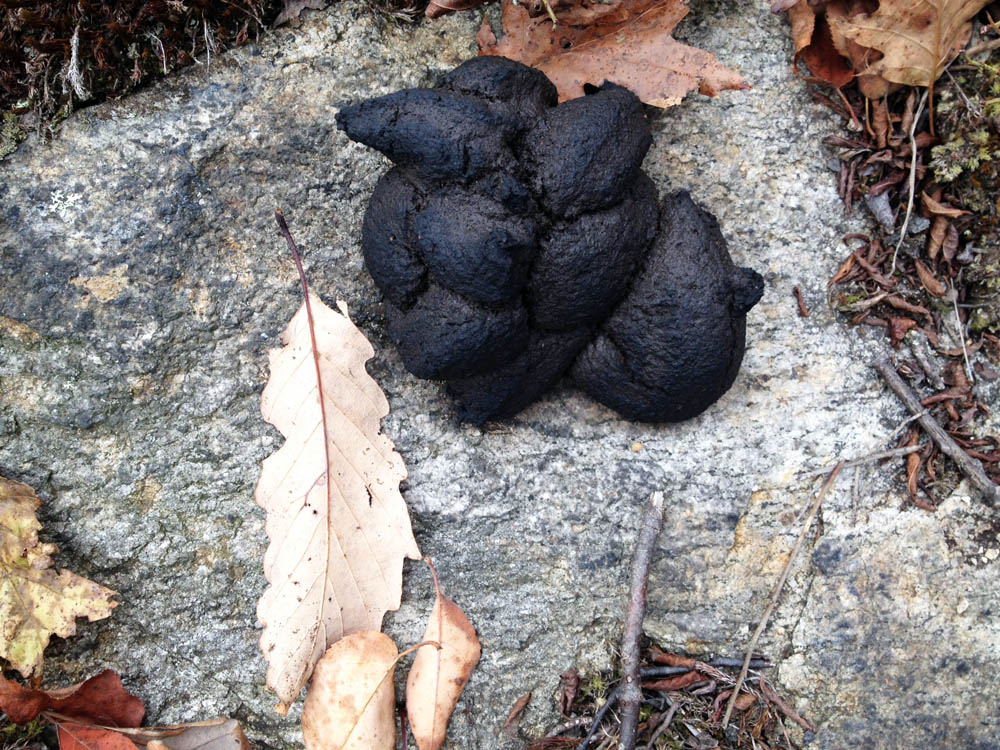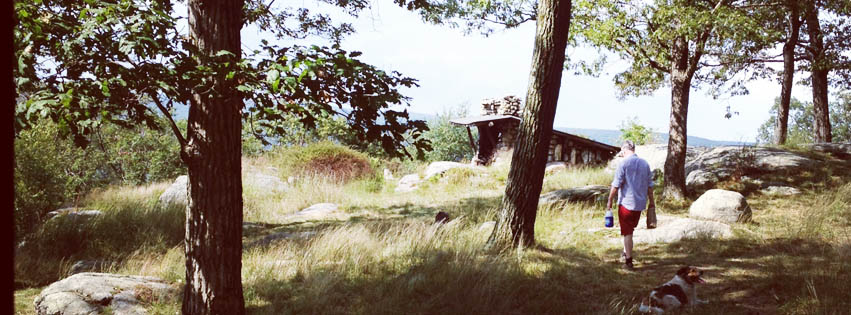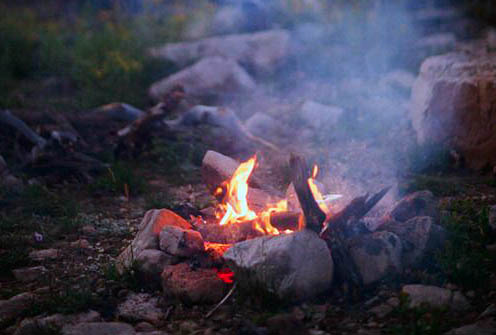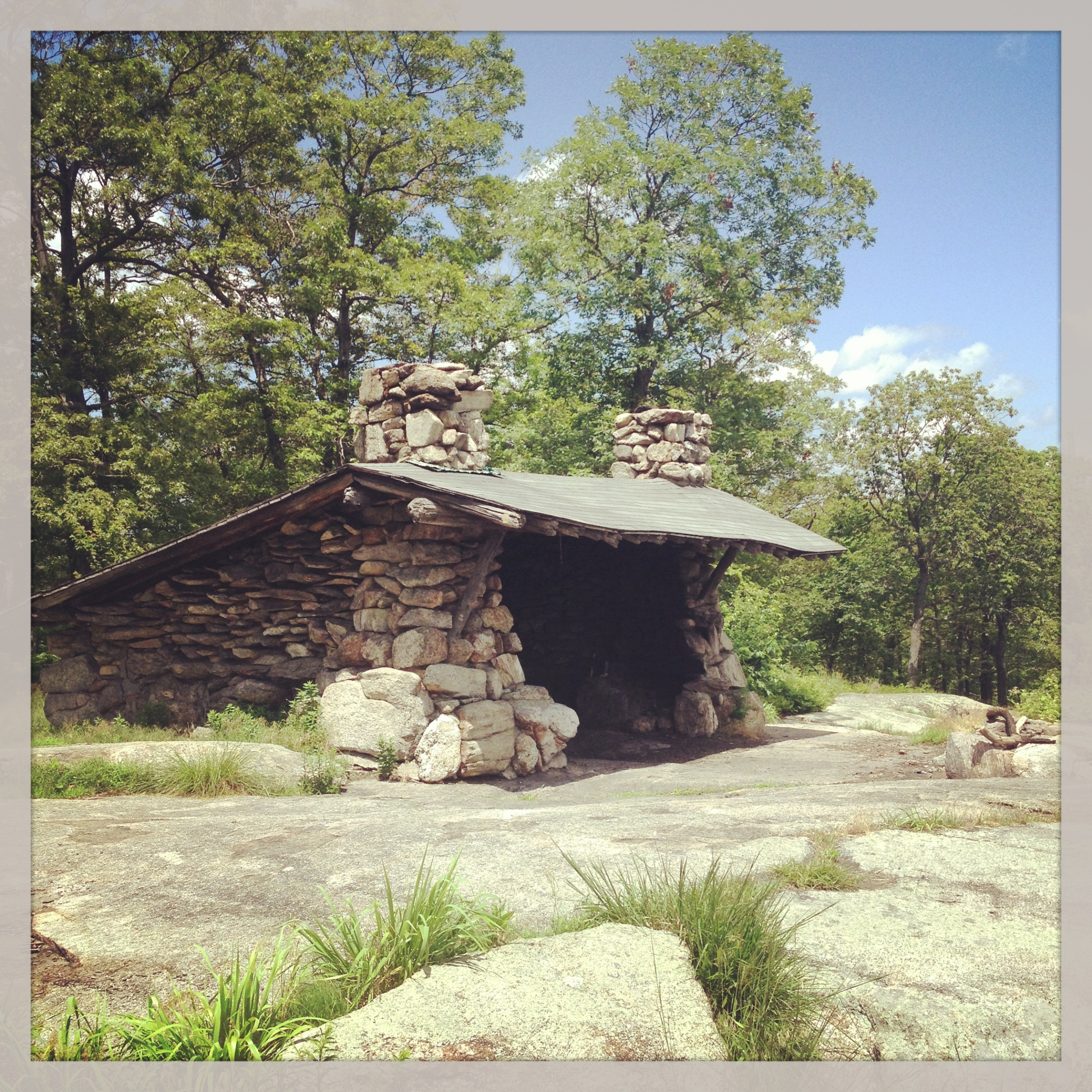A lean-to is a rustic, three-sided shelter built for the comfort of campers and hikers. In Harriman State Park, these shelters — nine of them, with two additional “ironsides” — are made of rough glacial boulders gathered at the site. Some have tin roofs, and some have shingles. The lean-tos are dispersed throughout the park but are generally in the back country, and must be hiked to. All of the Harriman lean-tos are located along the trails — you won’t have to bushwhack to reach them.
They were built by volunteers nearly 100 years ago. (Read this New York Times archived article from when the shelters were built: New huts constructed at Harriman State Park) Situated along the longer trails in the park to offer shelter to weary hikers for the night, they might have beautiful views, or access to water, or interior fireplaces. They all have big fire pits in their “front yards”, close enough to the shelter to offer warmth and light.
A camper or hiker can spend a night in one of these lean-tos, sleeping inside on a raised wooden platform or bunk bed, in front of a fireplace. The shelters are large enough to comfortably sleep almost a dozen hikers.
Some shelters have wonderful views of valleys or even New York City. Some are set on large grassy hilltops, with room (and fire pits) for several tents and campsites, in case the lean-to is filled to capacity.
So, plan your lean-to adventure soon. Spring, summer and fall are, it goes without saying, top seasons for lean-to camping, while the winter offers its own challenges and rewards (and for proof, read this account of camping in Harriman in the winter. Exhilarating and harrowing, and well-written throughout.)
Here are the rules, and some frequently asked questions:
The Rules of the Lean-To (the written, and unwritten)
- You can’t reserve the lean-tos; they are first-come, first-served only.
- You should only stay in the lean-to for a single night, and then move on. You can stay in a different lean-to the following night.
- Lean-tos are to be shared; you can offer to share the shelter with others who arrive after you, and you can expect to share the lean-to if you’re the later arrival. Or, you can pitch at tent or set up your hammock or sleeping bag nearby. Most of the Harriman lean-tos sleep eight — lots of room, but maybe it’s a bit weird when you’re sleeping next to a complete stranger.
- The DEC website reinforces the idea of sharing: “Lean-tos cannot be used exclusively and must be shared with other campers.”
- You are permitted to camp anywhere within 100 feet of the lean-to. Or, if you don’t have your tape measure with you, camp within sight of the shelter. The grassy areas around Tom Jones Shelter, Big Hill and Bald Rocks shelter are especially good for this.
- Clean the lean-to (and surrounding area) before leaving! Please.
- Make absolutely sure your fireplace is cold to the touch before you leave it. Know how to properly extinguish a fire.
- Never, ever keep food inside the lean-to with you, as there are all kinds of woodland critters who will ransack your shelter as you sleep (or don’t sleep). This includes the black bear — they have been seen hanging around Harriman shelters. Use a bear canister, or make sure your food is otherwise properly secured.
- Dispose of human waste by digging a hole 6″-8″ deep at least 150 feet from water or campsites. Cover with leaves and soil. This means: Bring a li’l shovel/trowel. (It’s really kind of gross to find bunches of toilet paper blooming behind boulders of Big Hill Shelter.
- Here’s a tip for your toilet paper, and it comes to you from the wisdom of thru-hikers. Save your ziploc Craisin bags (or any other plastic food bag that ziplocs and is opaque with printing). Fold toilet paper inside, sprinkle a little baking soda in there, and pack it in your backpack. After you’ve used the TP, put it back in the bag, zip it up (tight!) and pack it out.
Frequently-Asked Questions:
Q. Can I drive up to any of the shelters?
A. No. The shelters are accessible only by hiking in, and this is of course one of the pleasures of the lean-to! However, you can park at the trailheads and take a beautiful walk in.
This means you will have to plan your camping equipment carefully. Pack only what you need, and try to minimize the amount of trash you’ll be carrying out. Bring a water filter and collect water on your hike in.
Q. How many lean-tos are in Harriman?
A. There are a total of eleven commonly-used shelters. You have the historic lean-tos, which are:
- Stockbridge
- William Brien Memorial
- West Mountain
- Dutch Doctor
- Tom Jones
- Big Hill
- Bald Rocks
- Stone Memorial
- Fingerboard
…and then there are two metal structures (“ironsides”) of more modern vintage: Cohasset Shelter, along the Long Path, and one above the Kanawauke traffic circle (used by some of the group camps in the park).
There are others that are tucked away in the park, and these were built for more rustic getaways for campers in the group and children’s camps. One is above Lake Stahahe, just off the White Bar Trail.
Q. What are some of the features of each shelter?
A. Check out our page about the features of the historic lean-tos.
Q. Are there garbage cans close to the lean-tos?
A. NO! Strictly pack-it-in, pack-it-out. Don’t leave any trash (garbage, food scraps, paper plates, etc.) in the lean-to areas. Ever. :0)
Q. How long can I stay in one lean-to?
A. It is recommended that you only stay for one day, and then move along to try another lean-to.
Q. Are there any toilets nearby?
A. No. Follow the DEC guidelines in this matter: “Dispose of human waste by digging a hole 6″-8″ deep at least 150 feet from water or campsites. Cover with leaves and soil.”
Q. Where are the Harriman State Park lean-tos? How do I reach them?
A. Locate them on the map of Harriman State Park (download any of the maps, below). Plan your route ahead of time; decide which lean-to you’re going to stay in, and plan where you’ll park and what trails you’ll take. Download our free map: Harriman State Park Trails, Shelters and Parking Areas: A Free PDF Map to Download,
Q. Will local wildlife bother me?
A. In the wood, wildlife is present, be it raccoons, bears, or drunken campers. Keep all food out of the your tents and lean-tos. Hang it up or put it in a bear canister to protect yourself from rummaging, ransacking raccoons and beasties. Tell drunks to keep it down (politely).

Evidence of bears. Black bears have been seen hanging around the shelters at Harriman. Make sure you store your food outside the lean-to, in an appropriate bear canister.
Q. Is there water available?
A. Some shelters are located near water sources, but these can be unreliable, especially in July and August. Best to bring your own water.
Q. Will there be firewood?
A. If a shelter’s been used well, finding firewood can be a problem. You’ll have to leave yourself enough time between getting to a shelter and sundown to find firewood at a distance from the lean-to. Don’t rely on your fire to cook your food; bring a little camp stove.
If you have time, gather firewood to replace the wood you burned. Stack it near the overhang of the shelter, but outside the shelter and not on the wood floor inside.
Q. Can I leave my car overnight in a parking area?
A. Yes. Park only in areas designated with a “P” on the trail map (refer to the trail maps, the downloadable maps, or OpenStreetMap for parking areas.) All of the designated parking areas within Harriman State Park allow overnight parking.
Q. Does it cost anything to stay in a lean-to?
A. No.
Q. What are the chances of a lean-to being unoccupied for the night?
A. It varies throughout the year. On holiday weekends like Memorial Day, the park is naturally crowded and the lean-tos will probably be occupied, every last one of them. On beautiful summer weekends, you can expect the same thing.
In this case, you can either: 1) get there early to make sure you have a spot in the lean-to (although you might have to share it); 2) go to one of the lean-to spots that you know will have room in the surrounding area to camp, either in a tent or in a hammock. If you’re hammocking, do it on a night that’s clear and warm. 3). choose one of the lean-tos that furthest away from any parking area. Avoid Tom Jones and Bald Rocks shelters for that reason.
Q. Can I bring my well-behaved dog?
A. Yes, you can. For his own protection, make sure he’s not going to wander off in the night, or have a bear or other wildlife encounter. Don’t bring a barker — if there are other campers, they might not enjoy the vocalization. Make sure you have water for him. If he’s active, bring a frisbee, which can double as a dog dish when you’re not tossing it to him. And clean up after him!





